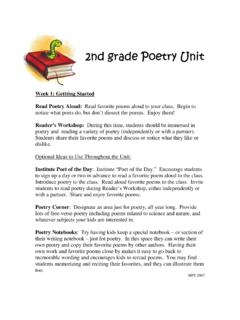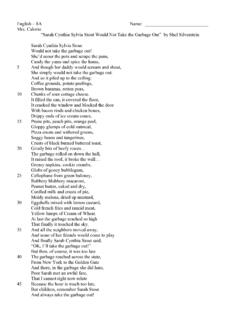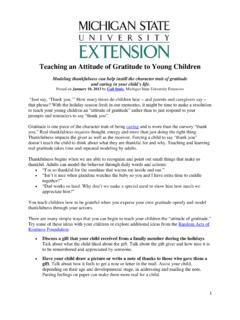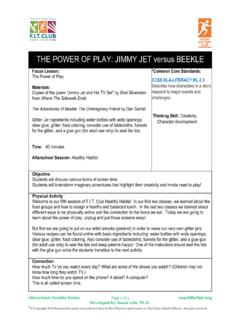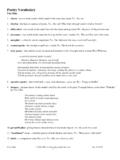Transcription of 5-Day Shared Reading Poem Lesson Plans Poem: …
1 5-Day Shared Reading Poem Lesson Plans Poem: Why is It? from Falling Up by shel silverstein Grade: 1st grade Standards Addressed: Identify words and phrases in stories or poems that suggest feelings or appeal to the senses. With prompting and support, read prose and poetry of appropriate complexity for grade 1. Demonstrate understanding of the organization and basic features of print. Demonstrate understanding of spoken words, syllables, and sounds (phonemes). Know and apply grade-level phonics and word analysis skills in decoding words. Read with sufficient accuracy and fluency to support comprehension. Participate in Shared research and writing projects ( , explore a number of how-to books on a given topic and use them to write a sequence of instructions). Participate in collaborative conversations with diverse partners about grade 1 topics and texts with peers and adults in small and larger groups. Ask and answer questions about key details in a text read aloud or information presented orally or through other media.
2 Produce complete sentences when appropriate to task and situation. Demonstrate command of the conventions of standard English grammar and usage when writing or speaking. Demonstrate command of the conventions of standard English capitalization, punctuation, and spelling when writing. With guidance and support from adults, demonstrate understanding of word relationships and nuances in word meanings. Lessons Day 1: Pointing Below Words Teaching Point: Track words with finger as you read Active Engagement: Teacher reads the poem out loud and models pointing below the words as he/she reads. Teacher tells children to notice how she points to each word as she reads it out loud. Class then does a choral Reading of poem. Teacher invites individual students to come to the front of the room and take turns pointing below the words as the class reads along. Independent Practice: Students are each given a copy of the poem to take home and practice pointing below the words as they read.
3 Day 2: Circling Letters Teaching Point: Identify and circle letters in the poem Active Engagement: The class engages in a choral Reading of the poem. Teacher then chooses a letter says it to the class and the students say the sound that letter makes. A volunteer then comes to the front of the room to find a word that begins with that letter in the poem and circle it with a marker. Students will take turns finding and circling words starting with that letter in the poem. Independent Practice: For homework, students will circle words beginning with a certain letters in a copy of the poem. Day 3: Mystery Sight Word Bag Teaching Point: Identifying sight words in the poem Active Engagement: The class engages in an echo Reading of the poem. Teacher chooses several sight words from the poem and writes each on an index card. Teacher puts the index cards in a bag and invites the a child to come up and choose a word from the bag. The child then has to read the word on the card and match it up with the word in the poem.
4 The teacher should continue to ask other children to come up one by one, take another word from the mystery bag, and match it to the poem. Independent Practice: For homework, students will read their copy of the poem and circle the sight words that were gone over in class. Day 4: Identifying Rhyming Words Teaching Point: Identify rhyming words in poem Active Engagement: Class will do a choral Reading of poem. Teacher will then ask students to identify words that rhyme in the poem. Teacher should remind students that rhyming words are words that have endings that sound the same. Teacher invites individual students to come up and circle the rhyming words in the poem. Teacher can then ask the class to come up with other words that rhyme with the rhyming words in the poem. Teacher can write down the list of rhyming words. Independent Practice: With a partner, students will think of words that rhyme with an other words in the poem.
5 Students should write their rhyming words in their word study notebooks. Day 5: Sentence Builders Teaching Point: Using words and punctuations to make sentences Active Engagement: The teacher writes the words and punctuation marks from the poem on separate index cards. Cards are distributed to the children and the children build a sentence by matching their cards to the words and punctuation marks in the poem. The teacher and children read the first line of the poem together. The teacher then asks the children if they have a word or punctuation mark from that line in the poem. The children then come up and put the words and punctuation marks from that line of the poem in order in a pocket chart. The teacher and students then continue the process, until the children build on the lines from the poem in the pocket chart. The class will then do a choral Reading of the poem. Independent Practice: For homework, students will complete a worksheet where they fill in missing words from the poem.
6 Children can reference their personal copy of the class poem.
